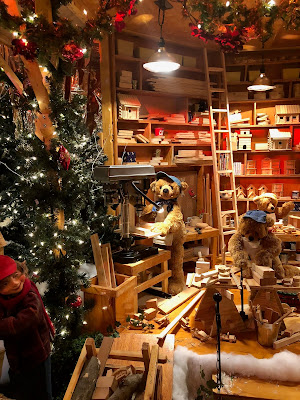On the streets of New York in August, ice cream trucks jingle, playground sprinklers splatter, flip-flops flap against sidewalks. Inside a warehouse in East Flatbush, however, elves are ice skating, bears are hammering, a polar bear is snoring, and dolls are waltzing to the strains of a miniature piano. Here, the sounds of summer have been replaced by the whirring and humming of minuscule motors, tinkling music, and the repetitive motions of dozens of mechanized creatures, most of whom appear to be in the throes of the winter holiday season.
This is the workshop of Lou Nasti, a Brooklyn-born Gepetto who has spent decades creating mechanical toys and displays for customers in Brooklyn and around the world. On the day of my visit, as I squinted to read the faded sign on the building, an auto mechanic in the next lot waved me down with his shop cloth. “You looking for Lou Nasti?” he called out. “Amazing guy. You’re going to love it in there.”
Locally, Lou is the brains behind the famous Christmas lawns of Dyker Heights, Brooklyn, with their soaring Santas and marching soldiers.
But other creations have made their way from Farragut Road to places as far-flung as Australia, Trinidad, and Morocco. With a white handlebar mustache and bushy eyebrows, wearing a canvas apron and suspenders, Lou Nasti looks every part the Sicilian toymaker.
He greets me ebulliently and escorts me through the workshop, flinging open doors to reveal singing angels, Christmas greenery woven into garlands, a reindeer under wraps, humongous revolving motors, an LED light tunnel with piped-in harp music, and rows of mute plastic heads.
At Lou Nasti Mechanical Displays, the Christmas season begins in March, following the International Toy Fair, where he meets many of his clients. Among Lou's most-requested displays is a “lost Santa” scenario for department stores. Generally, the plot revolves around Mrs. Claus and the elves tracking down Santa through various window scenes, ending up in the store itself as a lure to shoppers. (Lou notes that in his field, he has to be careful not to equate Santa with Christmas.) Another perennial request is talking trees: Lou does the voice himself.

Even at age five, Lou was making puppets with string and dancing them around his family’s home in Marine Park. In high school, he apprenticed for the Abraham & Straus display company, where his boss inspired him to pursue mechanical toys as a career. He started his own company at age nineteen, but it grew so fast that he decided to scale it back to keep the personal touch. Lou’s shop looks like a caricature of a toymaker’s workbench, with hammers and wrenches strewn about, wooden bins filled with metal parts, the walls lined with clipboards outlining each project, from sketch to completion.
Lou typically spends twelve hours a day here: “They’ll have to carry me out of here,” he says. “I eat, breathe, and drink this”—though he admits that sometimes he likes to unwind in the evening with his sketchbook and a beer at a local bar. Scattered around the room are the rotating motors that make the displays come alive.
Here’s how the magic unfolds. A customer comes to him with a vague idea for a scene (a typical one: “Lou, can you make me a winter wonderland?”), and he has to trust his imagination to transform it into something unique. He brings his morning coffee into the workshop and sits in front of the set, envisioning the directions it could take, until an idea begins to gel. Little by little, he fills in the details.
After his first sketches, he builds a mock-up and presents it to the client, but not even the model can prepare his customers—or Lou—for what happens when he flips the switch for the first time. It’s that moment that keeps his spark alive: “Watching a customer go absolutely Wow.”
In addition to Christmas lawn scenes for private clients, Lou has a few pet projects from his past. He transformed an Indiana car wash into a rain forest, where gorillas beat their chests and cars are doused by a herd of elephants. At the Quaker Bridge Mall in New Jersey, he created a crystal palace with trumpeting angels, mirrored arches, and ballet music.
Once, he even staged a Halloween party for the king of Morocco. So clandestine was the project, even Lou didn’t know where he was going or what he was doing until he stepped off the plane, was swept past customs, and was asked to turn over all his belongings except for his tape measure and a pen. As a limo ushered him down a long drive and into the palace rotunda, he realized where he was. He remembers saying to himself, “Not bad, a little guy from Brooklyn comes here!” Guess who called Brooklyn a few months later to ask about staging a holiday party.
Wedged between a cinder-block factory and an auto body shop, Lou Nasti's workshop revives my faith in wonderlands that lurk in the most unlikely places, places where our city's wizards wait to transform your dreams into sight and sound.
























































